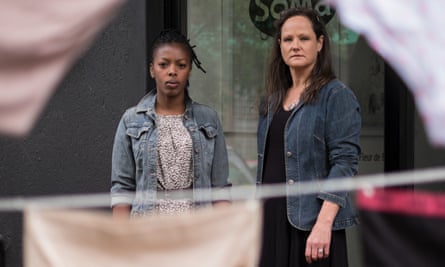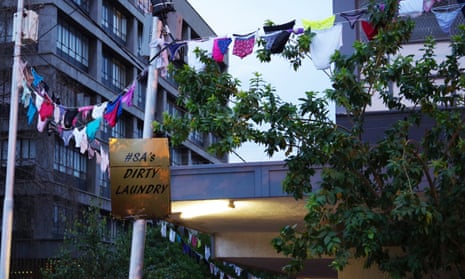Thousands of pairs of used knickers have been hung above the streets of Johannesburg as part of an installation to raise awareness about the country’s record rates of rape.
Devised by two sexual assault survivors, the installation consists of washing lines 1,200 metres long displaying 3,600 pairs of pants – matching the number of rapes estimated to occur on a daily basis, according to the artists.
Jenny Nijenhuis and Nondumiso Msimanga put out a public call for donations of underwear under the hashtag #SasDirtyLaundry, and set up a Facebook page, Pantiesplea. They arranged collection points across the city.
Carmen Ives, a volunteer who helped with the project, said each pair donated “speaks loudly” of severity of the situation in South Africa. “One pair of panties is one pair too many. It made me think that today, some girl is being raped somewhere,” she said.
On display until Sunday, the installation has received a largely positive response from the public. On Twitter, one user wrote that the project “feels like a movement”.
Another said the project connected “very deeply with experience of sexual assault, emotional abuse and trauma”.

However, the exhibition has faced questions over the rape statistics it uses.
While South Africa undisputedly has the highest rates of rape in the world, estimates on the number of assaults each day vary greatly. The 3,600-a-day estimate from the medical research council is far larger than the UN estimate of 132.
Responding to criticism Nijenhuis said that the figure was “symbolic”, adding that just a fraction of attacks are reported to the police.
Lisa Vetten, a research associate at Witwatersrand University in Johannesburg, said: “The problem of under-reporting [assault] means that we cannot know whether the drop [in recent rape statistics] is due to fewer rapes occurring, or fewer victims reporting.
“The most conservative research estimate suggests that only one in seven victims report being raped, but other studies suggest the figures may be higher.”

Africa Check, an organisation promoting accuracy in public debate and reporting, said the 3,600 figure remained unproven.
“When people use flawed statistics, and have a voice as is the case here, they neglect the complexity of issues, and make it seem like there are valid statistics, which is not the case,” said Anim van Wyk, editor-in-chief of Africa Check. “We need better statistics to do something about the root of the problem … to offer solutions.”
Anne Githuku-Shongwe, a representative for UN Women, said southern Africa was “the epicentre of the pandemic of violence against women and girls”, and the cost of violence “economically, physically and emotionally” must be recognised.
She advocated caution when using numbers. “[The exhibition] is great to spotlight the issue, but we must be careful not to sensationalise,” she said.
